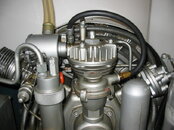pescador775
Contributor
- Messages
- 2,652
- Reaction score
- 14
When ordering connectors for oil gauge don't forget to also order an adapter to fit to the 1/4 inch pipe fitting on back of gauge.
Bauer seems confused about blow by.. I can't give you official numbers. Suggest you purchase a Brooks Instrument/rotameter, flow meter. Range, 0-1 cfm. These things are very expensive but sell on EBay for 20 bucks. If blow by at 3000 psi is not more than 0.5 cfm I would not replace any pistons or rings for now.
I assume your unit has the brass head on #3. Don't replace unless necessary.
Bauer seems confused about blow by.. I can't give you official numbers. Suggest you purchase a Brooks Instrument/rotameter, flow meter. Range, 0-1 cfm. These things are very expensive but sell on EBay for 20 bucks. If blow by at 3000 psi is not more than 0.5 cfm I would not replace any pistons or rings for now.
I assume your unit has the brass head on #3. Don't replace unless necessary.




